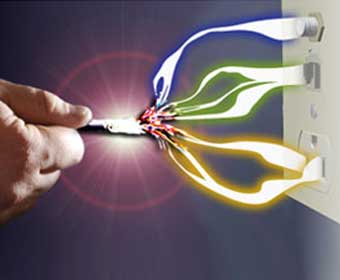Video over power lines closer to reality; wifi takes on Bluetooth
The HomeGrid Forum, a newly established trade group tasked with driving the ITU’s home networking specification, said this week that the standard is now stable enough to be adopted by silicon manufacturers.
October 15, 2009

The HomeGrid Forum, a newly established trade group tasked with driving the ITU’s home networking specification, said this week that the standard is now stable enough to be adopted by silicon manufacturers.
HomeGrid focuses on the development of a standard that will allow home networking over coax, power lines and phone lines – an ambitious project that has been decades in the making.
With connectivity seemingly moving in a wireless direction these days, it all sounds a bit retro – HomeGrid isn’t even talking about in-building networking over next generation fixed technologies like fibre, it’s talking about decades old, cloth covered power cables in crumbling British Victorian houses.
Yet HomeGrid spokesman David Thorne, who is also chief broadband and access strategist for BT, is surprisingly candid about the technology. “We’re not out to replace wifi,” he said at a meeting at BT’s central London headquarters this week. “This is a complementary technology to wireless. Wifi does a good enough job for connecting computers to the internet, but a hybrid system of fixed and wireless will be needed for higher bandwidth applications.
“If you’re not planning on moving video around the home, then you don’t need to consider this,” he said. “But if you are, then you can send it over any old wires.”
At the recent ITU conference in Geneva, the HomeGrid Forum announced the ratification of key components of the G.hn specification for networking over power lines. Although the technology has been in development for many years, it has been hindered by technical immaturity and fragmentation, resulting in a number of proprietary technologies being pushed by various vendors.
Fortunately, an accord was reached at the ITU event which allows coexistence between the G.hn specification and other wireline networking standards, resulting in a unified global standard for networking of content to devices over any wire – coax cable, phone line, and power line.
According to Thorne, this standard is now stable enough to allow silicon manufacturers to bring products to market. The BT strategist expects the technology to be built into consumer electronics such as set top boxes, multimedia systems and home security systems, and will allow content to be piped around the house to other devices plugged into the mains.
And in an age when consumers are faced with a plethora of new home networking technologies, such as femtocells, media centres and FMC, Thorne expects networking over power lines to be an easy sell. “It’s simple to market to the consumer,” he said, explaining that a user would plug one G.hn-enabled device into the mains in one room, and another into the mains in another room and they would communicate with each other.
In related news, another forum, the Wi-Fi Alliance on Wednesday announced a new specification that will allow wireless-enabled devices to communicate with each other in a similar fashion to the way Bluetooth already allows.
The specification, code named ‘Wi-Fi peer-to-peer,’ can be implemented in any wifi device, from mobile phones, cameras, printers, and notebook computers, to keyboards and headphones, and will allow said devices to more effectively connect in order to print, share and display.
Certified devices, which are expected to appear from 2010, will be branded Wi-Fi Direct, the alliance said.
About the Author(s)
You May Also Like








.png?width=300&auto=webp&quality=80&disable=upscale)


_1.jpg?width=300&auto=webp&quality=80&disable=upscale)


.png?width=800&auto=webp&quality=80&disable=upscale)